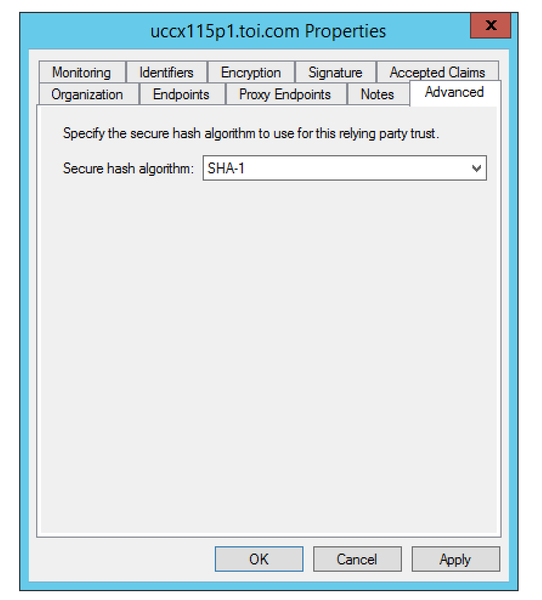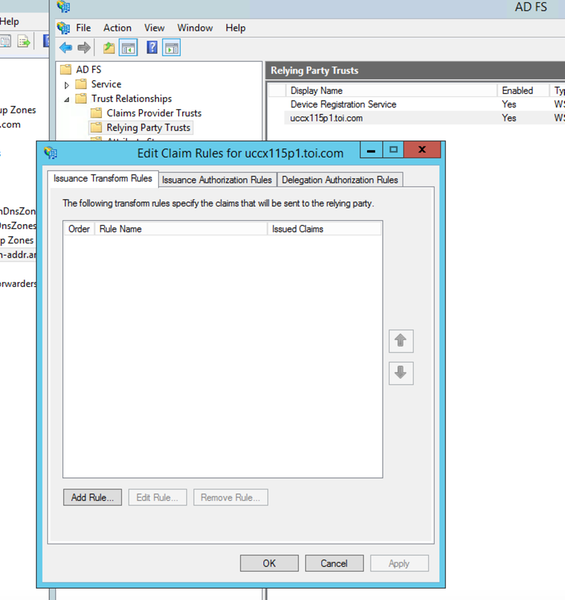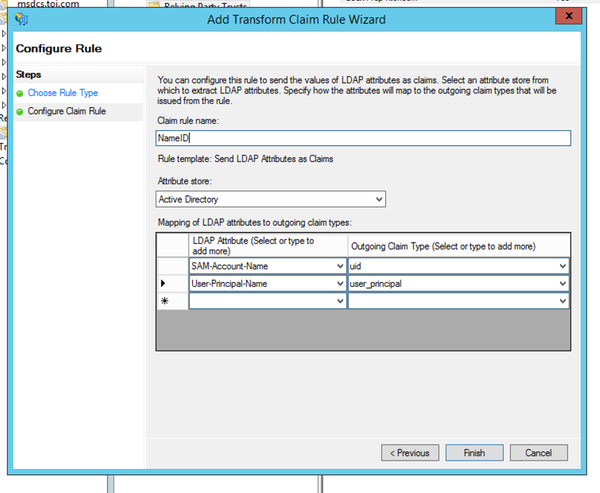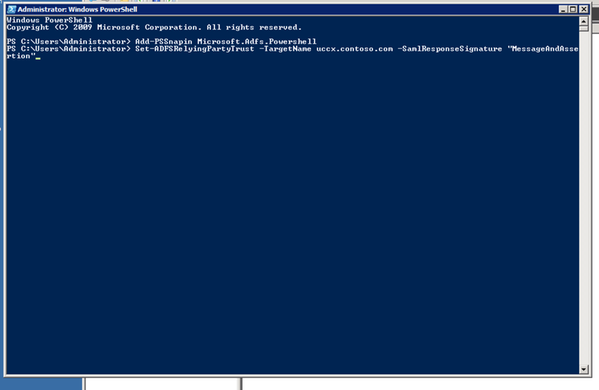ADFS/IdS Troubleshooting and Common Problems
Available Languages
Download Options
Bias-Free Language
The documentation set for this product strives to use bias-free language. For the purposes of this documentation set, bias-free is defined as language that does not imply discrimination based on age, disability, gender, racial identity, ethnic identity, sexual orientation, socioeconomic status, and intersectionality. Exceptions may be present in the documentation due to language that is hardcoded in the user interfaces of the product software, language used based on RFP documentation, or language that is used by a referenced third-party product. Learn more about how Cisco is using Inclusive Language.
Contents
Introduction
The Security Assertion Markup Language (SAML) interaction between Cisco Identity Service (IdS) and Active Directory Federation Services (AD FS) via a browser is the core of Single-Sign on (SSO) log in flow. This document will help you in debugging issues related to configurations in Cisco IdS and AD FS, along with the recommended action to resolve them.
Cisco IdS Deployment Models
| Product | Deployment |
| UCCX | Co-resident |
| PCCE | Co-resident with CUIC (Cisco Unified Intelligence Center) and LD (Live Data) |
| UCCE |
Co-resident with CUIC and LD for 2k deployments. Standalone for 4k and 12k deployments. |
Prerequisites
Requirements
Cisco recommends that you have knowledge of these topics:
- Cisco Unified Contact Center Express (UCCX) Release 11.5 or Cisco Unified Contact Center Enterprise Release 11.5 or Packaged Contact Center Enterprise (PCCE) Release 11.5 as applicable.
- Microsoft Active Directory - AD installed on Windows Server
- IdP (Identity Provider) - Active Directory Federation Service (AD FS) Version 2.0/3.0
Components Used
This document is not restricted to specific software and hardware versions.
The information in this document was created from the devices in a specific lab environment. All of the devices used in this document started with a cleared (default) configuration. If your network is live, make sure that you understand the potential impact of any command.
Background Information
After the trust relationship is established between Cisco IdS and AD FS (see here for details, common for UCCX and UCCE), the administrator is expected to run Test SSO Set up in the Settings page of Identity Service Management to ensure that the configuration between Cisco IdS and AD FS works fine. If the test fails, use the appropriate applications and suggestions given in this guide to resolve the issue.
Applications and logs that can be handy in debugging
|
Application/Log |
Details |
Where to find the tool |
|
Cisco IdS log |
Cisco IdS logger will log any error that happened in Cisco IdS. |
Use RTMT to get Cisco IdS logs. For information on how to use RTMT see, Guide to Use RTMT
Please note that the RTMT name is Cisco Identity Service. In order to find the logs, navigate to Cisco Identity Service > log |
|
Fedlet Logs |
Fedlet logs will give more details about any SAML errors that happens in Cisco IdS |
Use RTMT to get Fedlet logs. The location for Fedlet log is same as the Cisco IdS logs. The fedlet logs start with the prefix fedlet- |
|
Cisco IdS API metrics |
API metrics can be used to look into and validate any errors that Cisco IdS APIs may have returned and number of requests that are processed by Cisco idS |
Use RTMT to get API metrics. Please note that the RTMT name is Cisco Identity Service This will appear under a separate folder metrics. Please note that saml_metrics.csv and authorize_metrics.csv are the relevant metrics for this document.
|
|
Event Viewer in AD FS |
Allows users to view the event logs in the system. Any error in AD FS while processing the SAML request/sending the SAML response will be logged here. |
In AD FS machine, navigate to Event Viewer >Applications and Services Logs >AdDFS 2.0 > Admin
In Windows 2008, launch Event Viewer from Control Panel > Performance and Maintenance > Administrative Tools In Windows 2012, launch it from Control Panel\System and Security\Administrative Tools. Please look at your windows documentation to see where to find the Event Viewer. |
| SAML Viewer |
A SAML Viewer will help in looking at the SAML Request and Response that are sent from/to Cisco IdS. This browser application is very useful for the analysis of SAML Request/Response. |
These are some suggested SAML viewers that you can use for looking at the SAML request and response |
Flow Diagram with Debugging options
The various steps for SSO authentication is shown in the image along with and debugging artifacts at each step in case of a failure in that step.

This table gives the details on how to identify failures at each step of SSO in the browser. The different tools and how can they help in debugging is specified as well.
|
Step |
How to identify the failure in the Browser |
Tools/Log |
Configurations to look at |
|
AuthCode Request Processing by Cisco IdS |
In case of failure, the browser is not redirected to SAML endpoint or AD FS, a JSON error is shown by Cisco IdS, which indicates that the Client Id or Redirect URL is invalid. |
Cisco IdS logs- Indicates the errors which occur while the authcode request is validated and processed. Cisco IdS API metrics - Indicates the number of requests processed and failed. |
Client Registration |
|
SAML Request Initiation by Cisco IdS |
During failure, the browser is not redirected to AD FS, and an error page/message will be shown by Cisco IdS. |
Cisco IdS logs- Indicates whether there is an exception or not while the request is initiated. Cisco IdS API metrics - Indicates the number of requests processed and failed. |
Cisco IdS in NOT_CONFIGURED state. |
|
SAML Request Processing by AD FS |
Any failure to process this request will result in an error page being displayed by AD FS server instead of the login page. |
Event Viewer in AD FS- Indicates the errors which occur while the request is processed. SAML Browser Plugin - Helps to see the SAML request which is sent to the AD FS. |
Relying Party Trust Configuration in IdP |
|
Sending SAML Response by AD FS |
Any failure to send the response results in an error page being displayed by AD FS server after the valid credentials are submitted. |
Event Viewer in AD FS - Indicates the errors which occur while the request is processed. |
|
|
SAML Response processing by Cisco IdS |
Cisco IdS will show a 500 error with the error reason and a quick check page. |
Event Viewer in AD FS - Indicates the error if AD FS sends a SAML response without a successful status code. SAML Browser Plugin - Helps to see the SAML response sent by AD FS to identify what is wrong. Cisco IdS log - Indicates the error/exception occurred during the processing. Cisco IdS API metrics - Indicates the number of requests processed and failed. |
|
Authcode Request Processing by Cisco IdS
The starting point of SSO login, as far as the Cisco IdS is concerned, is the request for an authorization code from an SSO enabled application. The API request validation is done to check if it is a request from a registered client. A successful validation results in the browser being redirected to the SAML endpoint of Cisco IdS. Any failure in the request validation results in an error page/JSON (JavaScript Object Notation) being sent back from Cisco IdS.
Common Errors Encountered during this Process
1. Client Registration Not Done
|
Problem Summary |
Login request fails with 401 error on the browser. |
|
Error Message |
Browser: 401 error with this message: {"error":"invalid_client","error_description":"Invalid ClientId."} Cisco IdS Log: 2016-09-02 00:16:58.604 IST(+0530) [IdSEndPoints-51] WARN com.cisco.ccbu.ids IdSConfigImpl.java:121 - Client Id: fb308a80050b2021f974f48a72ef9518a5e7ca69 does not exist 2016-09-02 00:16:58.604 IST(+0530) [IdSEndPoints-51] ERROR com.cisco.ccbu.ids IdSOAuthEndPoint.java:45 - Exception processing auth request. org.apache.oltu.oauth2.common.exception.OAuthProblemException: invalid_client, Invalid ClientId. at org.apache.oltu.oauth2.common.exception.OAuthProblemException.error(OAuthProblemException.java:59) at com.cisco.ccbu.ids.auth.validator.IdSAuthorizeValidator.validateRequestParams(IdSAuthorizeValidator.java:55) at com.cisco.ccbu.ids.auth.validator.IdSAuthorizeValidator.validateRequiredParameters(IdSAuthorizeValidator.java:70) at org.apache.oltu.oauth2.as.request.OAuthRequest.validate(OAuthRequest.java:63)
|
|
Possible Cause |
The client registration with Cisco IdS is not complete. |
|
Recommended Action |
Navigate to Cisco IdS Management console and confirm if the client is registered successfully. If not, then register the clients before proceeding with SSO. |
2. User Accesses Application using IP Address/ Alternate Host Name
|
Problem Summary |
Login request fails with 401 error on the browser. |
|
Error Message |
Browser: 401 error with this message: {"error":"invalid_redirectUri","error_description":"Invlalid Redirect Uri"} |
|
Possible Cause |
User accesses application using IP Address/ Alternate Host Name. In SSO mode, if the application is accessed using IP, it does not work. Applications should be accessed by the hostname by which they are registered in Cisco IdS. This issue can happen if user accessed an alternate host name that is not registered with Cisco IdS. |
|
Recommended Action |
Navigate to Cisco IdS Management console and confirm if the client is registered with the correct redirect URLand the same is used to access the application.
|
SAML Request Initiation by Cisco IdS
SAML Endpoint of Cisco IdS is the starting point of the SAML flow in SSO based login. The initiation of the interaction between Cisco IdS and AD FS is triggered in this step. The prerequisite here is that the Cisco IdS should know the AD FS to connect to as the corresponding IdP metadata should be uploaded to Cisco IdS for this step to succeed.
Common Errors Encountered during this Process
1. AD FS Metadata not added to Cisco IdS
|
Problem Summary |
Login request fails with 503 error on the browser. |
|
Error Message |
Browser: 503 error with this message: {"error":"service_unavailable","error_description":"SAML Metadata is not initialized"} |
|
Possible Cause |
Idp Metadata is not available in Cisco IdS. Trust establishment between Cisco IdS and AD FS is not complete. |
|
Recommended Action |
Navigate to Cisco IdS Management console and see if the IdS is in Not Configured state. Confirm if IdP metadata is uploaded or not. If not, upload the IdP metadata downloaded from AD FS. For more details see here. |
SAML Request Processing by AD FS
SAML Request Processing is the first step in the AD FS in the SSO flow. The SAML request sent by the Cisco IdS is read, validated and deciphered by AD FS in this step. Successful processing of this request results in two scenarios:
-
- If it is a fresh log in in a browser, AD FS shows the login form.
-
If it is a relogin of an already authenticated user from an existing browser session, AD FS attempts to send the SAML response back directly.
Note: The main prerequisite for this step is for the AD FS to have the replying party trust configured.
Common Errors Encountered during this Process
1. AD FS not having the latest Cisco IdS’ SAML certificate.
|
Problem Summary |
AD FS not showing the login page, instead shows an error page. |
|
Error Message |
Browser AD FS shows an error page similar to this: There was a problem accessing the site. Try to browse to the site again. If the problem persists, contact the administrator of this site and provide the reference number to identify the problem. Reference number: 1ee602be-382c-4c49-af7a-5b70f3a7bd8e AD FS Event Viewer The Federation Service encountered an error while processing the SAML authentication request. Additional Data Exception details: Microsoft.IdentityModel.Protocols.XmlSignature.SignatureVerificationFailedException: MSIS0038: SAML Message has wrong signature. Issuer: 'myuccx.cisco.com'. at Microsoft.IdentityServer.Protocols.Saml.Contract.SamlContractUtility.CreateSamlMessage(MSISSamlBindingMessage message) at Microsoft.IdentityServer.Service.SamlProtocol.SamlProtocolService.CreateErrorMessage(CreateErrorMessageRequest createErrorMessageRequest) at Microsoft.IdentityServer.Service.SamlProtocol.SamlProtocolService.ProcessRequest(Message requestMessage) |
|
Possible Cause |
Relying party trust is not established or Cisco IdS certificate has changed, but the same is not uploaded to the AD FS. |
|
Recommended Action |
Establish trust between AD FS and Cisco IdS with the latest Cisco IdS certificate. Please ensure that the Cisco IdS Certificate is not expired. You can see the status dashboard in Cisco Identity Service Management. If so, regenerate the certificate in the Settings page. For more details on how to establish metadata trust across ADFS & Cisco IdS see, here |
SAML Response Sending by AD FS
The ADFS sends the SAML response back to the Cisco IdS via the browser after the user is successfully authenticated. ADFS can send a SAML response back with a status code which indicates Success or Failure. If form authentication is not enabled in AD FS then this will indicate a Failure response.
Common Errors Encountered during this Process
1. Form Authentication is not enabled in AD FS
|
Problem Summary |
Browser shows NTLM login, and then fails without successfully redirecting to Cisco IdS. |
|
Step of Failure |
Sending SAML Response |
|
Error Message |
Browser: Browser shows NTLM login, but after successful log in, it fails with many redirects. |
|
Possible Cause |
Cisco IdS supports only form based authentication, Form authentication is not enabled in AD FS. |
|
Recommended Action |
For more details on how to enable Form authentication see: |
SAML Response Processing by Cisco IdS
In this stage, Cisco IdS gets a SAML response from AD FS. This response could contain a status code that indicates Success or Failure. An error response from AD FS results into an error page and the same has to be debugged.
During a successful SAML response, the processing of the request can fail for these reasons:
- Incorrect IdP (AD FS) metadata.
- Failure to retrieve expected outgoing claims from AD FS.
- Cisco IdS and AD FS clocks are not synchronized.
Common Errors Encountered during this Process
1. AD FS Certificate in Cisco IdS is not the latest.
|
Problem Summary |
Login request fails with 500 error on the browser with Error Code as invalidSignature. |
|
Step of Failure |
SAML Response processing |
|
Error Message |
Browser: 500 error with this message in the browser: Error Code: invalidSignature AD FS Event Viewer: No error Cisco IdS Log: 2016-04-13 12:42:15.896 IST(+0530) default ERROR [IdSEndPoints-0] com.cisco.ccbu.ids IdSEndPoint.java:102 - Exception processing request com.sun.identity.saml2.common.SAML2Exception: The signing certificate does not match what's defined in the entity metadata. at com.sun.identity.saml2.xmlsig.FMSigProvider.verify(FMSigProvider.java:331) at com.sun.identity.saml2.protocol.impl.StatusResponseImpl.isSignatureValid(StatusResponseImpl.java:371) at com.sun.identity.saml2.profile.SPACSUtils.getResponseFromPost(SPACSUtils.java:985) at com.sun.identity.saml2.profile.SPACSUtils.getResponse(SPACSUtils.java:196) |
|
Possible Cause |
SAML Response processing failed as IdP certificate is different from what is available in Cisco IdS. |
|
Recommended Action |
Download the latest AD FS metadata from: https://<ADFSServer>/federationmetadata/2007-06/federationmetadata.xml And upload it to Cisco IdS via the Identity Service Managament user interface. For details , see Configure Cisco IdS and AD FS |
2. Cisco IdS and AD FS clocks are not Synchronized.
|
Problem Summary |
Login request fails with 500 error on the browser with the status code: urn:oasis:names:tc:SAML:2.0:status:Success |
|
Step of Failure |
SAML Response processing |
|
Error Message |
Browser: 500 error with this message: IdP configuration error : SAML processing failed SAML assertion failed from IdP with status code: urn:oasis:names:tc:SAML:2.0:status:Success. Verify IdP configuration and try again. Cisco IdS Log 2016-08-24 18:46:56.780 IST(+0530) [IdSEndPoints-SAML-22] ERROR com.cisco.ccbu.ids IdSSAMLAsyncServlet.java:298 - SAML response processing failed with exception com.sun.identity.saml2.common.SAML2Exception: The time in SubjectConfirmationData is invalid. at com.sun.identity.saml2.common.SAML2Utils.isBearerSubjectConfirmation(SAML2Utils.java:766) at com.sun.identity.saml2.common.SAML2Utils.verifyResponse(SAML2Utils.java:609) at com.sun.identity.saml2.profile.SPACSUtils.processResponse(SPACSUtils.java:1050) at com.sun.identity.saml2.profile.SPACSUtils.processResponseForFedlet(SPACSUtils.java:2038) at com.cisco.ccbu.ids.auth.api.IdSSAMLAsyncServlet.getAttributesMapFromSAMLResponse(IdSSAMLAsyncServlet.java:472) at com.cisco.ccbu.ids.auth.api.IdSSAMLAsyncServlet.processSamlPostResponse(IdSSAMLAsyncServlet.java:258) at com.cisco.ccbu.ids.auth.api.IdSSAMLAsyncServlet.processIdSEndPointRequest(IdSSAMLAsyncServlet.java:176) at com.cisco.ccbu.ids.auth.api.IdSEndPoint$1.run(IdSEndPoint.java:269) at java.util.concurrent.ThreadPoolExecutor.runWorker(ThreadPoolExecutor.java:1145) at java.util.concurrent.ThreadPoolExecutor$Worker.run(ThreadPoolExecutor.java:615) at java.lang.Thread.run(Thread.java:745)2016-08-24 18:24:20.510 IST(+0530) [pool-4-thread-1]
SAML Viewer: Look for the NotBefore and NotOnOrAfter fields <Conditions NotBefore="2016-08-28T14:45:03.325Z" NotOnOrAfter="2016-08-28T15:45:03.325Z"> |
|
Possible Cause |
Time in Cisco IdS and IdP system is out of sync. |
|
Recommended Action |
Synchronize the Time in Cisco IdS and AD FS system. It is recommended that AD FS system and Cisco IdS are time synchronized using NTP Server. |
3. Wrong Signature Algorithm (SHA256 vs SHA1) in AD FS
|
Problem Summary |
Login request fails with 500 error on the browser with status code:urn:oasis:names:tc:SAML:2.0:status:Responder Error Message in AD FS Event View Log – Wrong Signature Algorithm(SHA256 vs SHA1) in AD FS |
|
Step of Failure |
SAML Response processing |
|
Error Message |
Browser 500 error with this message: IdP configuration error : SAML processing failed SAML assertion failed from IdP with status code: urn:oasis:names:tc:SAML:2.0:status:Responder. Verify IdP configuration and try again. AD FS Event Viewer: Cisco IdS Log: ERROR com.cisco.ccbu.ids IdSSAMLAsyncServlet.java:298 - SAML response processing failed with exception com.sun.identity.saml2.common.SAML2Exception: Invalid Status code in Response. at com.sun.identity.saml2.common.SAML2Utils.verifyResponse(SAML2Utils.java:425) at com.sun.identity.saml2.profile.SPACSUtils.processResponse(SPACSUtils.java:1050) at com.sun.identity.saml2.profile.SPACSUtils.processResponseForFedlet(SPACSUtils.java:2038) at com.cisco.ccbu.ids.auth.api.IdSSAMLAsyncServlet.getAttributesMapFromSAMLResponse(IdSSAMLAsyncServlet.java:472) |
|
Possible Cause |
AD FS is configured to use SHA-256. |
|
Recommended Action |
Update AD FS to use SHA-1 for signing and encryption.
|
4. Outgoing Claim Rule not Configured Correctly
|
Problem Summary |
Login request fails with 500 error on the browser with message "Could not retrieve user identifier from SAML response./Could not retrieve user principal from SAML response." uid and/or user_principal not set in the outgoing claims. |
|
Step of Failure |
SAML Response processing |
|
Error Message |
Browser: 500 error with this message: IdP configuration error : SAML processing failed. Could not retrieve user identifier from SAML response./Could not retrieve user principal from SAML response. AD FS Event Viewer: No error Cisco IdS Log: ERROR com.cisco.ccbu.ids IdSSAMLAsyncServlet.java:294 - SAML response processing failed with exception com.sun.identity.saml.common.SAMLException: Could not retreive user identifier from SAML response. at com.cisco.ccbu.ids.auth.api.IdSSAMLAsyncServlet.validateSAMLAttributes(IdSSAMLAsyncServlet.java:231) at com.cisco.ccbu.ids.auth.api.IdSSAMLAsyncServlet.processSamlPostResponse(IdSSAMLAsyncServlet.java:263) at com.cisco.ccbu.ids.auth.api.IdSSAMLAsyncServlet.processIdSEndPointRequest(IdSSAMLAsyncServlet.java:176)
|
|
Possible Cause |
Mandatory outgoing claims (uid and user_principal) are not configured correctly in the Claim Rules. If you have not configured the NameID claim rule or either uid or user_principal is not configured properly. If NameID rule is not configured or user_principal is not mapped correctly, Cisco IdS indicates that user_principal is not retrieved since this is the property that Cisco IdS looks for. If uid is not mapped correctly, Cisco IdS indicates that uid is not retrieved. |
|
Recommended Action |
Under AD FS claim rules, ensure that attributes mapping for "user_principal" and "uid" are defined as in the IdP Configuration guide(which guide?).
|
5. Outgoing Claim Rule is not configured correctly in a Federated AD FS
|
Problem Summary |
Login request fails with 500 error on the browser with message "Could not retrieve user identifier from SAML response. or Could not retrieve user principal from SAML response." when the AD FS is a Federated AD FS. |
|
Step of Failure |
SAML Response processing |
|
Error Message |
Browser 500 error with this message: IdP configuration error : SAML processing failed Could not retrieve user identifier from SAML response./ Could not retrieve user principal from SAML response. AD FS Event Viewer: No error Cisco IdS Log: ERROR com.cisco.ccbu.ids IdSSAMLAsyncServlet.java:294 - SAML response processing failed with exception com.sun.identity.saml.common.SAMLException: Could not retreive user identifier from SAML response. at com.cisco.ccbu.ids.auth.api.IdSSAMLAsyncServlet.validateSAMLAttributes(IdSSAMLAsyncServlet.java:231) at com.cisco.ccbu.ids.auth.api.IdSSAMLAsyncServlet.processSamlPostResponse(IdSSAMLAsyncServlet.java:263) at com.cisco.ccbu.ids.auth.api.IdSSAMLAsyncServlet.processIdSEndPointRequest(IdSSAMLAsyncServlet.java:176)
|
|
Possible Cause |
In a Federated AD FS there are more configurations required that could be missing. |
|
Recommended Action |
Check if the AD FS configuration in Federated AD is done as per the section For a Multi-domain Configuration for Federated AD FS in Configure Cisco IdS and AD FS |
6. Custom Claim Rules not Configured Correctly
|
Problem Summary |
Login request fails with 500 error on the browser with message "Could not retrieve user identifier from SAML response./Could not retrieve user principal from SAML response." uid and/or user_principal not set in the outgoing claims. |
|
Step of Failure |
SAML Response processing |
|
Error Message |
Browser 500 error with this message: SAML assertion failed from IdP with status code: urn:oasis:names:tc:SAML:2.0:status:Requester/urn:oasis:names:tc:SAML:2.0:status:InvalidNameIDPolicy. Verify IdP configuration and try again.
The SAML authentication request had a NameID Policy that could not be satisfied. This request failed. User Action Cisco IdS Log: 2016-08-30 09:45:30.471 IST(+0530) [IdSEndPoints-SAML-82] INFO com.cisco.ccbu.ids SAML2SPAdapter.java:76 - SSO failed with code: 1. Response status: <samlp:Status> <samlp:StatusCode Value="urn:oasis:names:tc:SAML:2.0:status:Requester"> <samlp:StatusCode Value="urn:oasis:names:tc:SAML:2.0:status:InvalidNameIDPolicy"> </samlp:StatusCode> </samlp:StatusCode> </samlp:Status> for AuthnRequest: n/a 2016-08-30 09:45:30.471 IST(+0530) [IdSEndPoints-SAML-82] ERROR com.cisco.ccbu.ids IdSSAMLAsyncServlet.java:299 - SAML response processing failed with exception com.sun.identity.saml2.common.SAML2Exception: Invalid Status code in Response. at com.sun.identity.saml2.common.SAML2Utils.verifyResponse(SAML2Utils.java:425) at com.sun.identity.saml2.profile.SPACSUtils.processResponse(SPACSUtils.java:1050) at com.sun.identity.saml2.profile.SPACSUtils.processResponseForFedlet(SPACSUtils.java:2038) |
|
Possible Cause |
Custom claim rule is not configured correctly. |
|
Recommended Action |
Under AD FS claim rules, ensure that attributes mapping for "user_principal" and "uid" are defined as in configuration guide(which guide?).
|
7. Too Many Requests to AD FS.
|
Problem Summary |
Login request fails with 500 error on the browser with status code:urn:oasis:names:tc:SAML:2.0:status:Responder Error Message in AD FS Event View Log indicates there are too many requests to AD FS. |
|
Step of Failure |
SAML Response processing |
|
Error Message |
Browser 500 error with this message: IdP configuration error : SAML processing failed SAML assertion failed from IdP with status code: urn:oasis:names:tc:SAML:2.0:status:Responder. Verify IdP configuration and try again. AD FS Event Viewer: Microsoft.IdentityServer.Web.InvalidRequestException: MSIS7042: The same client browser session has made '6' requests in the last '16' seconds. Contact your administrator for details. at Microsoft.IdentityServer.Web.FederationPassiveAuthentication.UpdateLoopDetectionCookie() at Microsoft.IdentityServer.Web.FederationPassiveAuthentication.SendSignInResponse(MSISSignInResponse response)
Event Xml: <Event xmlns="http://schemas.microsoft.com/win/2004/08/events/event"> <System> <Provider Name="AD FS 2.0" Guid="{20E25DDB-09E5-404B-8A56-EDAE2F12EE81}" /> <EventID>364</EventID> <Version>0</Version> <Level>2</Level> <Task>0</Task> <Opcode>0</Opcode> <Keywords>0x8000000000000001</Keywords> <TimeCreated SystemTime="2016-04-19T12:14:58.474662600Z" /> <EventRecordID>29385</EventRecordID> <Correlation ActivityID="{98778DB0-869A-4DD5-B3B6-0565AC17BFFE}"/> <Execution ProcessID="2264" ThreadID="392" /> <Channel>AD FS 2.0/Admin</Channel> <Computer>myadfs.cisco.com</Computer> <Security UserID="S-1-5-21-1680627477-1295527365-1502263146-1105"/> </System> <UserData> <Event xmlns:auto-ns2="http://schemas.microsoft.com/win/2004/08/events" xmlns="http://schemas.microsoft.com/ActiveDirectoryFederationServices/2.0/Events"> <EventData> <Data>Microsoft.IdentityServer.Web.InvalidRequestException: MSIS7042: The same client browser session has made '6' requests in the last '16' seconds. Contact your administrator for details. at Microsoft.IdentityServer.Web.FederationPassiveAuthentication.UpdateLoopDetectionCookie() at Microsoft.IdentityServer.Web.FederationPassiveAuthentication.SendSignInResponse(MSISSignInResponse response) </Data> </EventData> </Event> </UserData> </Event> Cisco IdS Log 2016-04-15 16:19:01.220 EDT(-0400) default ERROR [IdSEndPoints-1] com.cisco.ccbu.ids IdSEndPoint.java:102 - Exception processing request com.sun.identity.saml2.common.SAML2Exception: Invalid Status code in Response. at com.sun.identity.saml2.common.SAML2Utils.verifyResponse(SAML2Utils.java:425) at com.sun.identity.saml2.profile.SPACSUtils.processResponse(SPACSUtils.java:1050) at com.sun.identity.saml2.profile.SPACSUtils.processResponseForFedlet(SPACSUtils.java:2038) at com.cisco.ccbu.ids.auth.api.IdSSAMLAsyncServlet.getAttributesMapFromSAMLResponse(IdSSAMLAsyncServlet.java:451)
|
|
Possible Cause |
There are too many requests coming to AD FS from the same browser session. |
|
Recommended Action |
This should typically not happen in production. But if you encounter this, you can:
|
8. AD FS is not Configured to Sign both Assertion and Message.
|
Problem Summary |
Login request fails with 500 error on the browser with Error Code:invalidSignature |
|
Step of Failure |
SAML Response processing |
|
Error Message |
Browser 500 error with this message: Error Code:invalidSignature Cisco IdS Log: 2016-08-24 10:53:10.494 IST(+0530) [IdSEndPoints-SAML-241] INFO saml2error.jsp saml2error_jsp.java:75 - SAML response processing failed with code: invalidSignature; message: Invalid signature in ArtifactResponse. 2016-08-24 10:53:10.494 IST(+0530) [IdSEndPoints-SAML-241] ERROR com.cisco.ccbu.ids IdSSAMLAsyncServlet.java:298 - SAML response processing failed with exception com.sun.identity.saml2.common.SAML2Exception: Invalid signature in Response. at com.sun.identity.saml2.profile.SPACSUtils.getResponseFromPost(SPACSUtils.java:994) at com.sun.identity.saml2.profile.SPACSUtils.getResponse(SPACSUtils.java:196) at com.sun.identity.saml2.profile.SPACSUtils.processResponseForFedlet(SPACSUtils.java:2028) at com.cisco.ccbu.ids.auth.api.IdSSAMLAsyncServlet.getAttributesMapFromSAMLResponse(IdSSAMLAsyncServlet.java:472) |
|
Possible Cause |
AD FS is not configured to sign both Assertion and Message. |
|
Recommended Action |
|
Related Information
This is related to the configuration of Identity Provider described in the article:
Contributed by Cisco Engineers
- Arundeep NCisco TAC Engineer
- Joji GeorgeCisco Engineering
Contact Cisco
- Open a Support Case

- (Requires a Cisco Service Contract)










 Feedback
Feedback